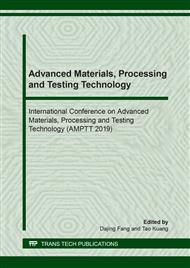[1]
Radisavljevic, B., et al., Single-layer MoS2 transistors. Nature Nanotechnology, 2011. 6(3): pp.147-150.
Google Scholar
[2]
Lee, C., et al., Anomalous Lattice Vibrations of Single- and Few-Layer MoS2. Acs Nano, 2010. 4(5): pp.2695-2700.
Google Scholar
[3]
Lauritsen, J.V., et al., Size-dependent structure of MoS2 nanocrystals. Nature Nanotechnology, 2007. 2(1): pp.53-58.
Google Scholar
[4]
Liu, K.K., et al., Growth of Large-Area and Highly Crystalline MoS2 Thin Layers on Insulating Substrates. Nano Letters, 2012. 12(3): pp.1538-1544.
Google Scholar
[5]
Lee, H.S., et al., MoS2 Nanosheet Phototransistors with Thickness-Modulated Optical Energy Gap. Nano Letters, 2012. 12(7): pp.3695-3700.
DOI: 10.1021/nl301485q
Google Scholar
[6]
Lee, Y.H., et al., Synthesis of Large-Area MoS2 Atomic Layers with Chemical Vapor Deposition. Advanced Materials, 2012. 24(17): pp.2320-2325.
Google Scholar
[7]
Li, Y., et al., Enhanced Li Adsorption and Diffusion on MoS2 Zigzag Nanoribbons by Edge Effects: A Computational Study. J Phys Chem Lett, 2012. 3(16): pp.2221-7.
DOI: 10.1021/jz300792n
Google Scholar
[8]
Chen, H., et al., Adsorption and Diffusion of Lithium on MoS2 Monolayer: The Role of Strain and Concentration. Int. J. Electrochem. Sci, 2013. 8: pp.2196-22003.
Google Scholar
[9]
Sun, X.L., Z.G. Wang, and Y.Q. Fu, Defect-Mediated Lithium Adsorption and Diffusion on Monolayer Molybdenum Disulfide. Scientific Reports, 2015. 5.
DOI: 10.1038/srep18712
Google Scholar
[10]
Zhou, W., et al., Intrinsic Structural Defects in Monolayer Molybdenum Disulfide. Nano Letters, 2013. 13(6): pp.2615-2622.
Google Scholar
[11]
Feng, L.-p., J. Su, and Z.-t. Liu, Effect of vacancies on structural, electronic and optical properties of monolayer MoS2: A first-principles study. Journal of Alloys and Compounds, 2014. 613: pp.122-127.
DOI: 10.1016/j.jallcom.2014.06.018
Google Scholar
[12]
Li, S., et al., Defects in silicene: vacancy clusters, extended line defects, and Di-adatoms. Sci Rep, 2015. 5: p.7881.
DOI: 10.1038/srep07881
Google Scholar
[13]
Liu, H., et al., Point defects in epitaxial silicene on Ag(111) surfaces. 2D Materials, 2016. 3(2): p.025034.
DOI: 10.1088/2053-1583/3/2/025034
Google Scholar
[14]
Datta, D., et al., Enhanced lithiation in defective graphene. Carbon, 2014. 80: pp.305-310.
Google Scholar
[15]
Soler, J.M., et al., The SIESTA method for ab initio order-N materials simulation. Journal of Physics-Condensed Matter, 2002. 14(11): pp.2745-2779.
DOI: 10.1088/0953-8984/14/11/302
Google Scholar
[16]
Lu, S., et al., Tunable redox potential of nonmetal doped monolayer MoS2: First principle calculations. Applied Surface Science, 2016. 384: pp.360-367.
DOI: 10.1016/j.apsusc.2016.05.038
Google Scholar
[17]
Wu, D.H., Y.F. Li, and Z. Zhou, First-principles studies on doped graphene as anode materials in lithium-ion batteries. Theoretical Chemistry Accounts, 2011. 130(2-3): pp.209-213.
DOI: 10.1007/s00214-011-0961-5
Google Scholar
[18]
Li, Y., et al., Enhanced Li Adsorption and Diffusion on MoS2 Zigzag Nanoribbons by Edge Effects: A Computational Study. J. Phys. Chem. Lett., 2012. 3(16): pp.2221-7.
DOI: 10.1021/jz300792n
Google Scholar
[19]
Jiang, H.R., et al., Boron phosphide monolayer as a potential anode material for alkali metal-based batteries. J. Mater. Chem. A, 2017. 5(2): pp.672-679.
DOI: 10.1039/c6ta09264k
Google Scholar


